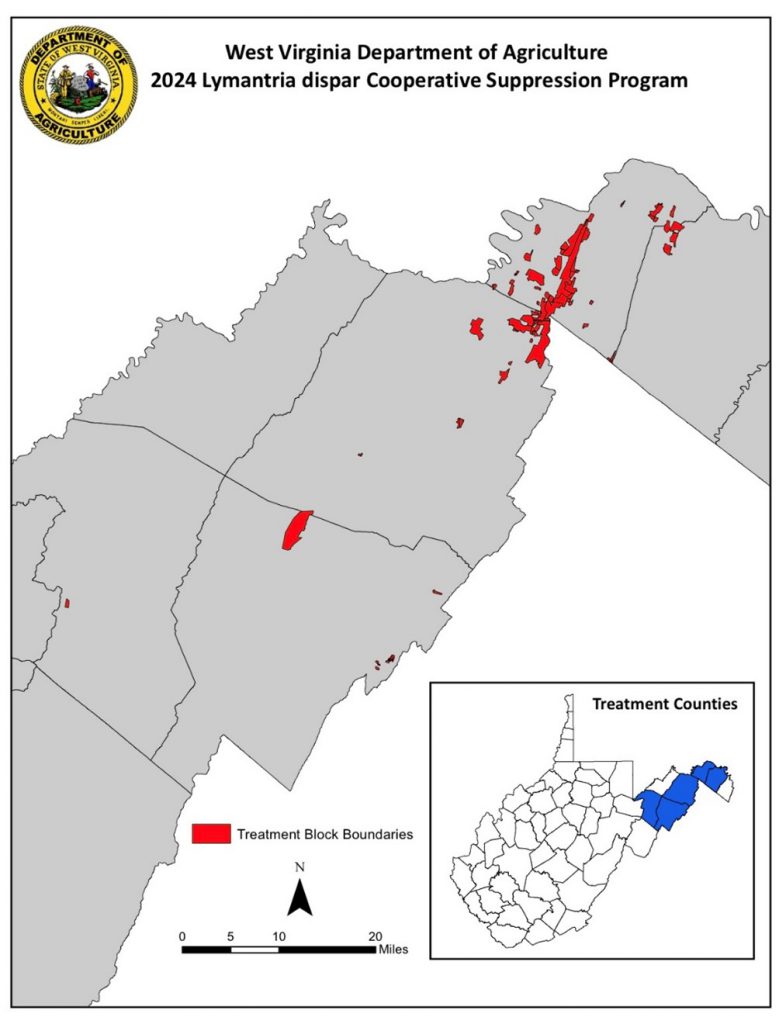</b>
CHARLESTON, W.Va. – West Virginia Department of Agriculture (WVDA), in cooperation with the United States Department of Agriculture-Forest Service (USDA-FS), is proposing aerial treatment of approximately 26,562 acres for the purpose of reducing significant impacts to forested lands within West Virginia caused by the Lymantria dispar (spongy moth aka gypsy moth). The WVDA proposes to treat these acres under the WVDA Cooperative State-County-Landowner (CSCL) Suppression Program.
WVDA officials are concerned that, without treatment, the Lymantria dispar infestations in West Virginia will reach high enough levels to cause defoliation and possible tree mortality. Large numbers of caterpillars are expected in the 2024 treatment areas. It is likely that many already stressed trees will not be able to withstand additional heavy defoliation and will die. Water quality, recreation experiences, wildlife habitat, and timber production could all be negatively affected. Excessive mortality will also reduce visual quality.
The young Lymantria dispar caterpillars are spread by the wind, which blows the silken threads they exude, creating a parachute effect. Movement by this mechanism tends to be slow. However, humans have sped the process up considerably by unwittingly transporting The the pest as eggs or caterpillars on firewood, RV’s, campers, and other vehicles. WVDA officials caution against the transport of firewood into or out of the state because pests such as the Lymantria dispar, hemlock woolly adelgid, emerald ash borer, spotted lanternfly and other invasive insects may be in or on the wood. These non-native pests have potentially devastating economic effects. Owners of RV’s and campers are asked to thoroughly inspect and wash their equipment before moving it. Even with all of these precautions the Lymantria dispar has and will continue to spread, leaving site specific treatments as the only way to reduce population explosions and resulting tree mortality.
The WVDA anticipates the possibility of significant defoliation in 2024 because of an increase in the Lymantria dispar population in areas of Berkeley, Grant, Hampshire, Hardy and Morgan Counties. The Lymantria dispar fungus, Entomophaga maimaiga, though present, did not prevent the deposit of large, healthy, and viable egg masses in 2023.
Landowners within the CSCL Program area of West Virginia contacted the WVDA to have their properties surveyed to determine if they contain Lymantria dispar populations in quantities high enough to produce possible tree mortality, defoliation, or a significant nuisance factor in the spring of 2024. Areas with 500 egg masses per acre (em/ac) or higher are designated for possible treatment on properties considered wooded residential, wooded recreational or non-residential forested land. The areas proposed for treatment are delineated on topographic maps and a contract, deposit invoice, and signature map of the proposed spray block boundaries are sent to the landowner.
The landowners in the CSCL Program signed a contract with the West Virginia Department of Agriculture and paid a deposit, thus confirming the requested treatment for their Lymantria dispar problem. The landowners selected the spray material to be used on their property and verified their property boundaries. The proposed treatment would consist of one application of a specific control agent. These agents are a bacterium known as Foray 48B (BTK), which affects young caterpillars with minimum effects on other insects and animals or Mimic 2LV (Tebufenozide) which has a very low toxicity to all mammals and aquatic species.
Approximately 26,582 acres of forest land are proposed for treatment with Mimic 2LV or Foray 48B in Berkeley, Grant, Hampshire, Hardy and Morgan counties. The adjoining map shows the general location of the proposed treatment areas. More detailed maps with specific locations of the proposed treatment areas are available for review at the New Creek office of the WVDA Plant Industries Division. These areas will be treated during May 2024. The specific dates will depend on weather conditions and the stage of development of the Lymantria dispar.
The WVDA has consulted with the WV Division of Natural Resources Wildlife Resources Biologist and the United States Department of the Interior Fish and Wildlife Service concerning the presence of any rare, threatened, or endangered species (RTE) within the proposed treatment area. Both agencies concurred that the project is not likely to adversely affect RTE species.
The WVDA will immediately begin solicitation of public comment on the areas proposed for treatment and will use this input to identify any significant issues related to the proposed project and to develop a range of alternatives. Any comments, concerns or interest in this proposed project should be submitted in writing to Jeff Johnson or Tom Pownall, P.O. Box 9, New Creek, WV 26743 or via e-mail to jjohnson@wvda.us or tpowall@wvda.us no later than April 1, 2024.

The West Virginia Department of Agriculture protects plant, animal and human health through a variety of scientific, regulatory and consumer protection programs. The Commissioner of Agriculture is one of six statewide elected officials who sits on the Board of Public Works.
